Figure 2.
Osa physically interacts with Pnr and Chip through its C-terminal EHD. Osa4H consequently no longer interacts with Pnr and Chip. (A) Schematic drawing of the Osa domains used throughout the current study. They are as follows: Osa A, Meth1/Ser581; Osa B, Ser581/Ala903; Osa C, Thr897/Tyr1370; Osa D, Tyr1370/His1740; Osa E, His1733/Glu2550; Osa F, Ala2339/Ala2715. (B,C) Osa interacts with Pnr (B) and with Chip (C). In each case, an immunoblot of a representative set of transfected cells extracts is shown in the upper part of the panels. Immunoprecipitations of transfected cell extracts are shown in the lower part of the panels. The transfected expression vectors are shown at the top of the panels. The B10 and M2 mouse antibodies used to immunoprecipitate the extracts are shown at the left of the panels and the antibodies used to reveal the blots are indicated at the bottom. Pnr is recognized by the 2B8 monoclonal antibody, the B10-tagged Osa domains are detected with the B10 antibody, and the full-length flagged Chip is detected with the M2 antibody. The locations of the Osa domains are indicated by arrowheads. The locations of the flagged Chip and Pnr proteins as well as those of the immunoglobulin heavy chain [IgG(H)] are indicated at the sides. (D) Osa4H no longer interacts with Pnr or Chip. The layout is as in B and C. The stars highlight the absence of Pnr (lane 13) and F-Chip (lane 14) coimmunoprecipitating with immunoprecipitated B10.Osa4H.

